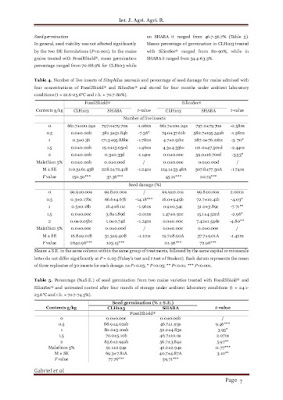Abstract
Influence of maize varieties CLH103 and SHABA on the effectiveness of FossilShield® and SilicoSec® against Sitophilus zeamais was evaluated in laboratory. Each product was used at 0, 0.5, 1, 1.5 and 2 g/kg and four exposure periods (1, 3, 7 and 14 days) for adult mortality and F1 progeny production. Damaged and germinated seeds were also assessed. Malathion (positive control) was used at the recommended dosage (0.5 g/kg).
Publisher Name: INNSPUB
Discussion
In this study, the mortality of Sitophiluszeamais caused individually by FossilShield® and SilicoSec® on the two maize
varieties was significantly high compared to the untreated control. This
mortality increased with concentrations and days of exposure. Similar results
were obtained by a number of previous studies on different beetles exposed to
different DE formulations (Ceruti et al., 2008; Matti and Awaknavar, 2009; Nukenine
et al., 2010; Athanassiou et al., 2011; Shams et al., 2011; Khakame et al.,
2012; Chiriloaie et al., 2014; Shafighi et al., 2014). The work done by these
authors showed the increased mortality of beetles with increased days of
exposure. For each DE formulation used in the present study, mortality of S.
zeamais did not exceed 10% with the two maize varieties within 1 day of
exposure. But with increased concentration and exposure periods, this mortality
was total at higher for the two maize varieties. The insecticidal efficacy of
DE is determined by its degree of adherence to the kernel, a physical
characteristic of each type of grain (Korunic, 1997, 1998). Athanassiou et al.
(2005) and Nukenine et al. (2010) reported similar results with SilicoSec® on stored
wheat against of S. oryzae (L.) and on maize against S. zeamais respectively.
Since DE acts as a desiccant; when DE particles are picked up by the insect
cuticle, the epicuticular layer is destroyed, resulting in death through water
loss (Korunic, 1998; Subramanyam and Roesli, 2000). This might explain the
highest mortality of weevil at the highest concentration of each DE in this
study because active compound increase with the increased concentration so the
insect picks up more DE particles in the highest concentration. In our study,
the difference on the percentage of reduction in F1 emergence were observed on
both maize varieties treated with each DE formulation according to the t-test
of Student. Additionally, regardless of the initial number of adults exposed to
treated maize, percentage of progeny reduction in treatment, compared to
control, was higher for the two maize varieties treated with each DE in all
exposure periods (1, 3, 7 and 14). FossilShield® and SilicoSec® were more
effective on CLH103 (total reduction from 1.5 g/kg). This could be due to the
total mortality of parents in the mortality test at these concentrations.
Effective control of protectants is qualified as mortality of adult and/or
immature, confirmed by lack of progeny generation (Hertlein et al., 2011). On
the other hand, on SHABA treated with each DE formulation, the percentage
reduction in adult emergence was not total even at 2 g/kg. this could be due to
the higher level of grain moisture content (13.20%) which is one of the most
important factors influencing efficacy of DE in pest control products (Khakame
et al., 2012). Our results agree with those of Mewis and Ulrichs (2001) who did
not recorded total suppression progeny emergence of S. granaries, insect of the
same family as S. zeamais exposed to FossilShield® despite the total
mortality recorded. Seed damaged was significantly reduced for the two maize
varieties treated with each diatomaceous earth after four months of storage.
Matti and Awaknavar (2009) observed no percentage of seed damage in the sorghum
treated with Protect-It at the dosage of 0.1 g. The studies of the previous
authors agree with ours in the case of CLH103 variety treated with both DEs
which recorded no percentage of seed damage at the concentration of 2 g/kg. In
the SHABA variety, damage observed on grains may be attributed to the increase
of population. Furthermore, the grains moisture content is one of the most
important factors affecting efficacy of DE in pest control products (Khakame et
al., 2012). The moisture content of the two maize varieties used here were
respectively 11.30% and 13.20% for CLH103 and SHABA under the ambient
laboratory conditions (t ≈ 22.6-25.6°C; r.h. ≈ 70.7-80%). For that reason, the
higher moisture content of SHABA variety compared to CLH103 may decrease the
efficacy of DEs and permitted the development of S. zeamais (Snelson, 1987;
Afridi et al., 2001). In additional to reduce seed damages, since the mode of
action of DE dusts is the desiccation, lower grain moisture content also
increased their efficacy (Fields and Korunic, 2000). Khakame et al. (2012)
observed in their study that when moisture content increased from 10 to 16%,
the progeny emerged in grain treated with Actellic Super® dust increased from 0
to 0.5 compared to the untreated grain. Generally seed viability was not
affected by each DE. Matti and Awaknavar (2009) reported that Protect-it did
not have negative effects on seed germination even exposed at different
temperature and relative humidity. Also Nukenine et al. (2010) recorded
percentage of germination of maize treated with SilicoSec® ranged between
66.7-70.0%. Our results suggest that the viability of the two maize varieties
was not affected by each DE. However, the percentage of seed germination varies
according the maize variety. Akob and Ewete (2007) observed that E. grandis ash
at 2 g/2kg of maize protected grains for 6 months without any adverse effect on
seeds germination. According to Couturon (1980), when environmental conditions
are not well controlled, germination rate decreases quickly. That could partly
explain the loss of viability. Get the full Articles by following the link




















0 comments:
Post a Comment